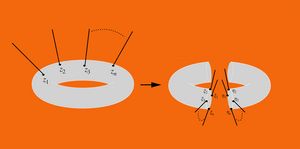String theory is a promising solution for a profound problem: How does everyday gravitation behave on the short distance scales where the phenomena of quantum physics become noticeable?
In the basic approach of string theory, the fundamental objects of physics are no longer point-like particles but rather one-dimensional objects, so-called strings.
It appears that the strings move through a ten-dimensional space-time and must be supersymmetrical there. This assumption has many consequences: for example, that besides the strings there are also higher-dimensional objects, so-called D-branes.
A central question is how our familiar four-dimensional space-time, with the physics known to us, can be derived from this higher-dimensional theory.
In this context, the string theory group at MPP deals with different compactification scenarios. In doing so, the theorists also investigate what implications these have for particle physics and cosmology. Furthermore, we study general properties of quantum gravity and string theory in the framework of the swampland program. Among other things, it deals with the question which quantum field theories allow a consistent embedding in string theory at low energies or in quantum gravity at high energies - and for which quantum field theories this is not the case. The latter then belong to the so-called swampland.
Further, they are studying the quantum properties of black holes and the structure of quantum scattering processes in quantum field theory and quantum gravitation as well as the mathematical properties of compactifications, and non-associative algebras in particular.
String theory at the MPP
Phone number: +49 89 32354-extension
| name | function | extension | office | |
|---|---|---|---|---|
| Anastasi, Edoardo | Visiting Scientist | edoardo.anastasi | 284 | A.3.57 |
| Aparici Domingo, Miquel | Student | miquel.aparici | 251 | A.3.30 |
| Artime, Manuel | Student | manuel.artime | 593 | A.3.31 |
| Basile, Ivano, Dr. | Postdoc | ivano.basile | 267 | A.3.38 |
| Bersigotti, Leonardo | PhD Student | leonardo.bersigotti | 321 | A.3.37 |
| Bischof, Andreas | PhD Student | andreas.bischof | 201 | A.3.30 |
| Blumenhagen, Ralph, PD Dr. | Senior Scientist | ralph.blumenhagen | 276 | A.3.27 |
| Borys, Alessandro | Student | alessandro.borys | 284 | A.3.57 |
| Delgado, Matilda, Dr. | Postdoc | matilda.delgado | 267 | A.3.34 |
| Fraiman, Bernardo, Dr. | Postdoc | bernardo.fraiman | 594 | A.3.25 |
| Gligovic, Aleksandar | PhD Student | aleksandar.gligovic | 273 | A.3.35 |
| Herraez, Alvaro | Postdoc | alvaro.herraez | 321 | A.3.34 |
| Junghans, Daniel, Dr. | Postdoc | daniel.junghans | 284 | A.3.57 |
| Kervyn, Xavier | Student | xavier.kervyn | 593 | A.3.31 |
| Kneißl, Christian | PhD Student | christian.kneissl | 251 | A.3.30 |
| Lüst, Dieter, Prof. Dr. | Director | dieter.luest | 282 | A.3.43 |
| Masias Teves, Joaquin Aurelio | PhD Student | joaquin.masias | 273 | A.3.35 |
| Montella, Carmine | PhD Student | carmine.montella | 321 | A.3.37 |
| Novicic, Dusan | PhD Student | dusan.novicic | LMU | LMU |
| Paraskevopoulou, Antonia | PhD Student | antonia.paraskevopoulou | 293 | A.3.35 |
| Raml, Thomas | PhD Student | thomas.raml | 406 | A.3.30 |
| Siammenos, Fotis | Student | fotis.siammenos | 593 | A.3.31 |
| Staudt, Georgina | PhD Student | georgina.staudt | 293 | A.3.37 |
| Stieberger, Stephan, Dr. | Senior Scientist | stephan.stieberger | 310 | A.3.23 |
| Sturm, Annette | Secretary | annette.sturm | 482 | A.3.45 |
| Tazzoli, Giulia | Student | giulia.tazzoli | 251 | A.3.30 |
| Valcelli, Filippo | Student | filippo.valcelli | 206 | A.3.25 |
| Zatti, Matteo, Dr. | Postdoc | matteo.zatti | 206 | A.3.25 |
X. Bekaert, J. Erdmenger, D. Ponomarev and C. Sleight,
Quartic AdS Interactions in Higher-Spin Gravity from Conformal Field Theory
Journal of High Energy Physics 1511 (2015) 149
arXiv:1508.0429
R. Blumenhagen, A. Font, M. Fuchs, D. Herschmann, E. Plauschinn, Y. Sekiguchi, F. Wolf
"A Flux-Scaling Scenario for High-Scale Moduli Stabilization in String
Theory", Nucl.Phys. B897 (2015) 500-554
arXiv:1503.07634
G. Dvali, C. Gomez, R. Isermann, D. Lüst, S. Stieberger
Black Hole Formation and Classicalization in ultra-Planckian 2 -> N Scattering
Nucl.Phys. 893 (2015) 187
arXiv:1409.7405
A. Font, I. Garcia Etxebarria, D. Lüst, S. Massai, C. Mayrhofer
Heterotic T-fects, 6D SCFTs and F-Theory
arXiv:1603.09361




